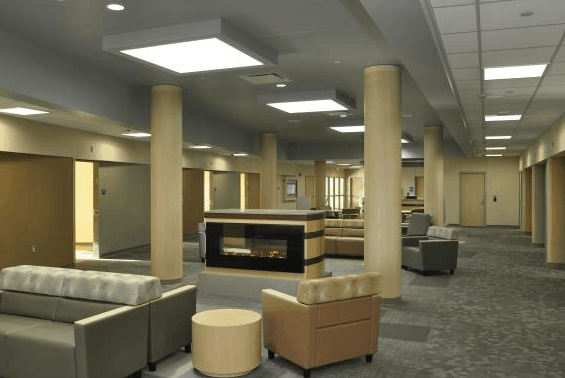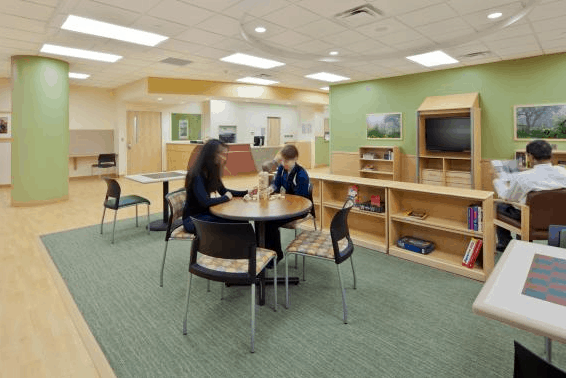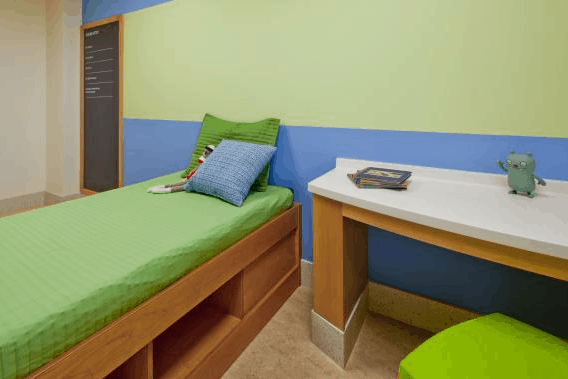Blog
Rethinking Behavioral Health Center Design

The following post was originally featured in Healthcare Design Magazine and may be seen here. It is an interview with Don Thomas, a principal at St. Paul, Minn.-based BWBR.
In this Q&A with Healthcare Design magazine, Thomas discusses next-generation facility design, what works and what doesn’t, and what he’d like to see happen in the future.

The design of Regions Hospital Inpatient Mental Health Center includes open public areas and accessible nurses’ stations. Photo credit: Brandon Stengel – www.farmkidstudios.com

The design of Regions Hospital Inpatient Mental Health Center includes open public areas and accessible nurses’ stations. Photo credit: Brandon Stengel – www.farmkidstudios.com

A patient room at Amplatz Children’s Hospital includes an area to store personal belongings. Photo credit: Brandon Stengel – www.farmkidstudios.com
Behavioral health centers have come a long way from the days when security and durability governed their design. A lot of those changes come from better design principles in general, such as improved access to natural light, amenities that empower and stimulate patients, and facilities that promote independence and healing. “Everything that we’ve learned about how design can influence physical health, we need to be applying to mental health, because in the end, it has the same effect,” says Don Thomas, a principal at St. Paul, Minn.-based BWBR.
 In this Q&A with Healthcare Design magazine, Thomas discusses next-generation facility design, what works and what doesn’t, and what he’d like to see happen in the future.Healthcare Design: Why is there a growing demand for behavioral health services in the United States?
In this Q&A with Healthcare Design magazine, Thomas discusses next-generation facility design, what works and what doesn’t, and what he’d like to see happen in the future.Healthcare Design: Why is there a growing demand for behavioral health services in the United States?
Don Thomas: The one reason we hear the most is, “It’s about time.” Most behavioral healthcare units are typically tucked away inside a hospital or various wards. What they’ve been discovering is when they put people in bright, healthy, healing-type environments, they respond better, they’re in the hospital less time than expected, and then they can move on to life sooner. From our point of view, we’re seeing huge leaps of faith from organizations to expand and grow their departments because they’ve been in the background of healthcare for so long. But they’re realizing that there are so many people in need that they just have to step forward and grow their departments, and when they do, the community responds.
HCD: What was the design approach for behavioral healthcare facilities in the past?
Thomas: Usually it was much more seclusion, security, and safety. They designed facilities to be almost locked-down. The caregivers were behind glass, only specifically trained individuals were allowed on the floor, and family members weren’t encouraged to visit, let alone be on the floor. There was no artwork, no color, not a lot of amenities at all. Mostly it was about safety.
HCD: How has the design approach changed in the last 10 years?
Thomas: Thankfully, safety hasn’t gone by the wayside. It’s still the primary concern of caregivers for all their patients—it’s just smarter. The design of the facilities has become much more mainstream with creating healing environments that are pleasant. There’s more natural lighting, there’s more color, it’s more humane. Art becomes a huge component. They’ve tried to reduce barriers between caregivers and patients, and create a community for the patients that allows them to explore illness and understand and accept it, and move forward. Some areas still have high security, and there are many appropriate rules to make sure that they don’t put them in harm’s way. But the real ideas are that if patients are engaged and conversational, from a healing point of view, they begin to get better faster.
HCD: When the Avera Behavioral Health Center opened in 2006, it incorporated many design approaches that were not the norm in mental healthcare at the time, such as large day areas, open nurses’ stations, and the incorporation of color, natural accents, and artwork. Why was the time right to push the boundaries?
Thomas: There were many things that they were looking at. Their program was expanding and it was successful, but it was still hidden on the fourth floor. The other part was that the leadership of Avera was focused on caring for all people and this [project] aligned with their mission. So this worked from a business, a vision, and a practical/corporate point of view. The decision was to put them out next to a hospital that had an ED and be a standalone facility. That hadn’t been done in 15 years.
At the time, we couldn’t go around any place to tour because there was no place to tour. So we held a number of design workshops to do prototyping and design charrettes, and we met with patients and staff. We came up with a different model, and it works very well. Avera doesn’t have corridors; it has lots of open spaces for patients to walk to. There are thresholds and safety zones. For a lot of things, we just felt it was the right thing to do. To this day, [administrators from other facilities] come through the facility to see it.
HCD: Five years later you conducted a post-occupancy evaluation on Avera. What lessons came out of that and how do they direct your design work going forward?
Thomas: Our question was, for all that effort, all that money, the art, the lighting, the design—did it make a difference? The response from the patients in particular was yes, it absolutely made a difference. They said it felt more like they could open up, communicate, and come out of their shells, and that it helped family members understand their illness. There was also an enormous cultural shift with the caregivers. It was now patient-centered care, not control-focused care, which a lot of behavioral health had up to that point. Some of the staff was on board and some was not. The idea was the sooner we help them act differently and care differently, it’s hopeful.
However, a number of things were not that successful. One of the things that sticks in my mind is that every patient room has a small desk and a window to look out at nature. We thought it would be perfect to put the desk in front of the window. But when you’re paranoid or schizophrenic, you don’t want to have your back to the door. So when we worked on a project in St. Paul, even though we were in the middle of construction, we turned every single desk so that it was next to the window but not facing out. Then we took some patients over there and said if we turn the desk like this does it make a difference, and they said it did. It’s the small things like that.
In a good news/bad news way, we also learned that there wasn’t enough space for families at Avera. Before we did this, nobody came to visit except a priest or maybe your doctor. Now the good news is that families want to come visit.
HCD: When you consider next-generation facility design, what stands out to you?
Thomas: Single patient rooms, the incorporation of nature, and natural lighting, whether it’s skylights or big windows. Wherever there’s natural light, people will gather. There’s a sense of calmness and a healing component associated with light.
HCD: Does the issue of safety in behavioral health centers restrict what you can put in these spaces?
Thomas: No, you can put in lots of things, but you can put in the wrong things. For instance, I’m looking at a door with hinges and a handle. We couldn’t put that in a behavioral health hospital because you could strap something to the top of the hinge or to the door handle, even though it props down. And there are physical considerations. Patients typically need to be observed every 15 to 20 minutes, depending on their acuity. We designed the layout of the [patient] room so staff can make sure they’re fine by glancing in the room without intruding too much on the patient’s personal space. So the room layouts are generally more open and they’re more inviting, just as a result of the need to observe.
HCD: What would you like to see happen with the design of behavioral health centers going forward?
Thomas: First of all, whether we do it or somebody else, I’d like to see more of them. I also believe we’re going to see the integration of behavioral healthcare into mainstream hospitals. If you have a cancer center, there should be a unit there at the cancer center to deal with temporary issues. The same thing is true with a birthing center or hospice, so it’s not separate from the continuum of care for people. I also think there’s going to be an evolution to do more outpatient care and make it more normalized so that maybe 10 years from now, we’ll be talking about a mental wellness facility. It would have an enormous impact on our lives if we can address these things much earlier.
Anne DiNardo is senior editor of Healthcare Design. She can be reached at adinardo@vendomegrp.com.







